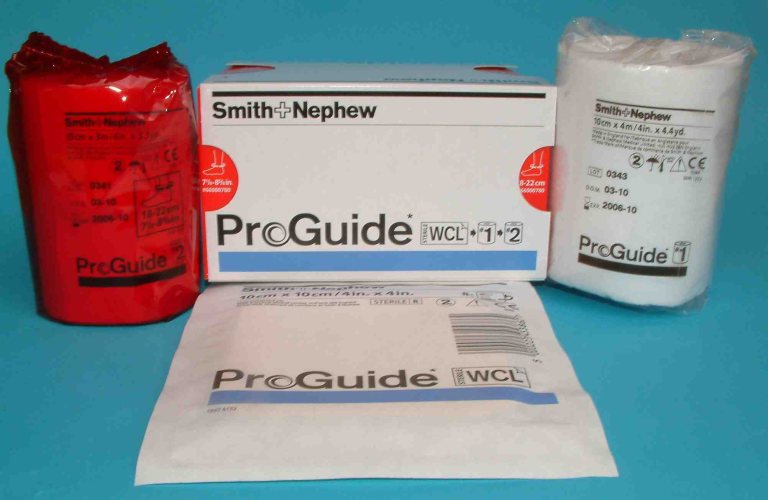
| Product Name: | ProGuide |
| Classification Name: | Multilayer Bandage Compression System |
| Manufacturer: | Smith & Nephew Healthcare Ltd |
Proguide is a multi-layer system for treating venous leg ulcers. It comprises a kit containing three components; a primary dressing, a roll of absorbent padding and a compression bandage.

The primary dressing consists of a piece of absorbent hydrophilic polyurethane foam, sandwiched between two perforated wound contact layers. The foam is highly absorbent, capable of retaining fluid even under compression, thus reducing the possibility of leakage or maceration.
The padding layer is formed from a mixture of polyester and viscose fibres, needled together to form a soft, stable fleece that is smooth to the touch. The primary purpose of this layer is to protect bony prominences from excess pressure, but it also serves as a secondary absorbent layer in the treatment of heavily exuding ulcers.
The third layer is a woven compression bandage coated with a pressure sensitive hot melt adhesive applied in a ladder pattern to reduce slippage and keep system in place for extended periods. The adhesive is latex-free and does not contain colophony or other potential skin sensitizers.
The bandage contains elastomeric yarns with unique properties. When stretched, the tension within the structure initially increases in a similar way to conventional elastomeric materials but then reversible changes take place in the chemical structure of the polymer that enable further extension of the bandage with relatively little additional applied force. This property effectively limits the maximum tension developed within the bandage fabric during extension and subsequent application, and thereby controls sub-bandage pressure.
Correct application of the bandage is facilitated by the presence of a coloured centre line to enable a 50% overlap, and a printed application aid provides guidance on the degree of extension required to produce clinically effective levels of compression. The guide consists of an oval containing two intersecting lines that change to a circle with the intersecting lines forming a right angle when the bandage is extended to the centre of its working range.
Because sub-bandage pressure is directly proportional to bandage tension but inversely proportional to limb circumference, different levels of bandage tension will be required for limbs of different sizes. Three different kits are therefore available containing bandages that have been developed to produce a predetermined level of compression (40 mm Hg) on legs of specific dimensions. Proguide is used for the treatment of venous leg ulcers and associated conditions.
Proguide is used for the treatment of venous leg ulcers and associated conditions.
Proguide should not be used for the treatment of ischaemic limbs or in any other situation where sustained compression is contra-indicated.
Select a kit appropriate to the circumference of the ankle to be treated. Remove a primary dressing from its packaging and apply directly to the wound (additional dressings may be used for larger wounds). As the primary dressing has a wound contact layer on each surface, it does not matter which side is placed in contact with the wound bed.
With the primary dressing in place, apply the padding, without any tension, working from the base of the toes to the knee. First wrap the padding around the foot, complete an ankle lock and take the padding around the back of the ankle and return across the top of the foot ensuring that the heel and foot are well covered. Proceed from the ankle to the knee using a simple spiral technique at 50% overlap. Cut off excess padding. If required strips of this excess material can be applied alongside the tibia or around the malleoli (ankle bones) to provide additional protection to these vulnerable areas.
With the padding in place, apply the compression bandage from the base of the toes to the ankle using minimal tension. Wrap the bandage around the foot, complete an ankle lock and take the bandage around the back of the ankle and return across the top of the foot to cover the padding. Note that the bandage has been extended too much if the compression guide becomes a circle at this stage.
Continue to apply the bandage from the ankle to the knee using a simple spiral technique, as described in the instructions supplied with the product, slightly overstretching the bandage then allowing it to relax before it is applied, until the compression guide becomes a circle and the two intersecting lines are at right angles. Cut off any excess bandage and secure the bandage with tape.
Proguide can be worn for up to 7 days, depending on the level of exudate. At the start of treatment it may be necessary to change the bandage twice a week as the oedema reduces.
Proguide should not be applied to patients with significant arterial impairment. Care must be taken to ensure that the compression bandage is applied exactly as directed in the instructions using a simple spiral with a 50% overlap. A figure of eight technique should not be used as this would result in more than two layers of fabric and the formation of excessively high levels of sub-bandage pressure.
Proguide is supplied in a cardboard outer containing three components; a primary dressing, a roll of absorbent padding and a compression bandage.
The bandage has a shelf life of three years from the date of manufacture.
The bandages are available in three sizes colour coded as follows.
Ankle circumference (Colour Code)
18-22cm (Red)
22-28cm (Yellow)
28-32cm (Green)
Thomas S., and Fram P., An evaluation of a new type of compression bandaging system, http://www.worldwidewounds.com/2003/september/Thomas/New-Compression-Bandage.html
Further information on obtaining Smith &Nephew products is available on the Smith &Nephew web site.
| Revision Author | Dr S. Thomas |
| Revision No | 1.4 |
| Revision date | 2006/01/23 |
This datacard has been prepared from data provided by the manufacturer and/or from published literature.